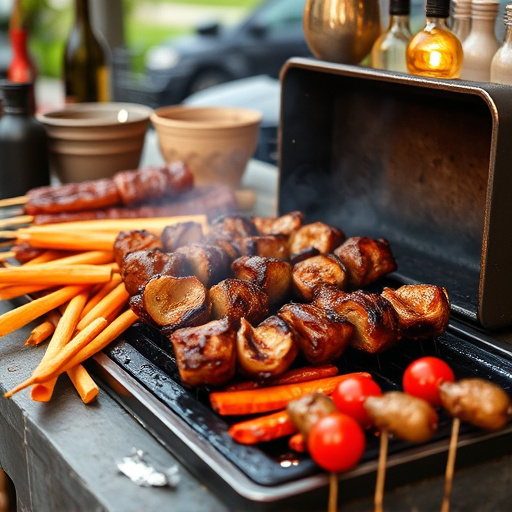The perfect BBQ Beef Brisket Sandwich starts with understanding brisket's unique composition and mastering its preparation techniques. Seasoning, slow smoking, and collagen breakdown at low temperatures ensure a tender, flavorful meat. Creative toppings and proper storage/reheating complete the experience. Craft your ideal BBQ Beef Brisket Recipe using these essential elements.
Unleash the ultimate BBQ experience with a fall-apart tender brisket, perfect for crafting mouthwatering sandwiches. This comprehensive guide takes you on a journey from understanding the cut’s unique characteristics to mastering seasoning and smoking techniques. Learn the science behind its tender transformation and discover optimal cooking times. Explore creative sandwich pairings and expert storage tips to ensure your BBQ beef brisket recipe remains deliciously moist.
- Understanding Brisket: The Cut and Its Characteristics
- Seasoning 101: Marinades and Rubs for Flavor Infusion
- Smoking Techniques: Achieving the Perfect Fall-Apart Tenderness
- The Science Behind Fall-Apart Meat: Collagen Breakdown
- Cooking Times and Temperatures: A Comprehensive Guide
- Resting and Slicing: Ensuring Maximum Juicy Results
- Creative Sandwich Ideas: Pairing Brisket with Toppings
- Storage and Reheating: Keeping Your BBQ Brisket Delicious
Understanding Brisket: The Cut and Its Characteristics

Brisket, a cut from the beef chest, is a staple in BBQ culture, especially for those seeking the perfect sandwich filling. When shopping for a BBQ beef brisket recipe, look for this specific cut, known for its rich marbling and thick layers. Marbling refers to the intramuscular fat distribution, which not only contributes to the meat’s flavor but also ensures it remains tender during slow cooking.
This distinctive cut is composed of both lean and fatty portions, creating a complex taste profile. The exterior tends to be more firm and well-seasoned, while the interior becomes incredibly tender when cooked low and slow. This characteristic makes brisket ideal for sandwiches, as the combination of juicy, flavorful meat and crispy outer layers enhances each bite.
Seasoning 101: Marinades and Rubs for Flavor Infusion

When it comes to crafting the perfect BBQ beef brisket recipe, seasoning is key. The right combination of marinades and rubs can transform a simple piece of meat into a mouthwatering masterpiece. Marinades are a great way to infuse moisture and flavor into your brisket before cooking. They’re typically made with a mixture of acids (like vinegar or citrus juices), oils, spices, and herbs, creating a flavorful solution to dip or brush onto the meat. These liquids not only add taste but also help break down some of the muscle fibers, making the brisket tenderer.
Rubs, on the other hand, are dry seasonings that create an outer crust on the beef. Spices like salt, pepper, paprika, and brown sugar are commonly used to make a rub. These seasonings stick to the meat’s surface, providing a burst of flavor as they caramelize during the cooking process. For a truly exceptional brisket, consider experimenting with different spice blends and combining them with a simple marinade for an irresistible BBQ beef brisket recipe that will have your taste buds dancing.
Smoking Techniques: Achieving the Perfect Fall-Apart Tenderness
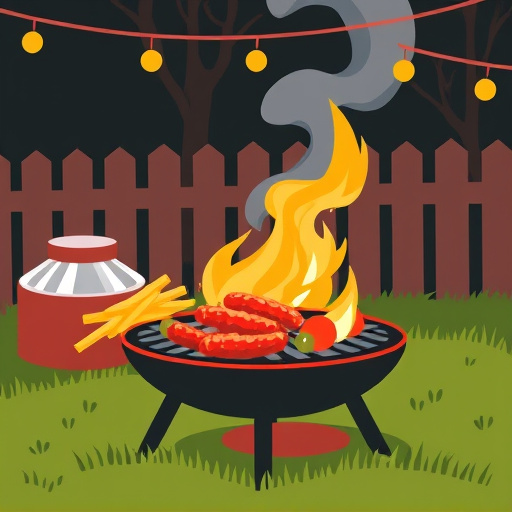
To achieve the perfect fall-apart tenderness in your BBQ beef brisket recipe, understanding and mastering smoking techniques is key. The art of slow cooking at low temperatures is a game-changer for this cut of meat. Ideally, maintain a consistent temperature between 225°F to 250°F (107°C to 121°C) using your smoker. This gentle approach allows the collagen in the brisket to slowly break down, resulting in tender, mouthwatering meat that practically falls apart when sliced.
Experimenting with different smoking methods can further enhance the taste and texture. Some prefer using a combination of direct heat and indirect heat, where you alternate between cooking directly over hot coals or wood chips for a period, followed by moving the brisket to an area with reduced heat to continue slow-roasting. This technique not only ensures even cooking but also contributes to that desirable smoky flavor that elevates any BBQ beef brisket recipe.
The Science Behind Fall-Apart Meat: Collagen Breakdown
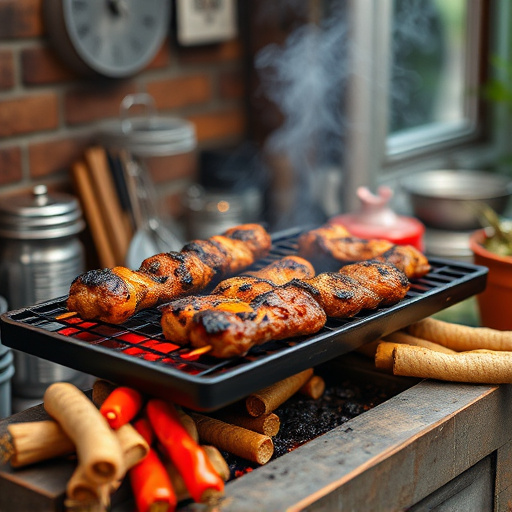
The secret behind the perfect fall-apart BBQ brisket, ideal for crafting mouthwatering sandwiches, lies in the science of collagen breakdown. Collagen is a protein that binds muscle fibers together, giving meat its structure and toughness. In the case of brisket, which is known for its dense and tough nature, the transformation from a solid piece of meat to tender, pull-apart flakes is a culinary marvel.
During slow cooking, whether it’s through smoking or braising, heat gradually breaks down collagen into gelatin. This process not only makes the brisket incredibly tender but also adds moisture, resulting in a juicy and flavorful sandwich filling. The longer the meat cooks, the more collagen transforms, ensuring each bite is a delightful combination of rich BBQ flavors and melt-in-your-mouth texture—the hallmark of a successful BBQ beef brisket recipe.
Cooking Times and Temperatures: A Comprehensive Guide
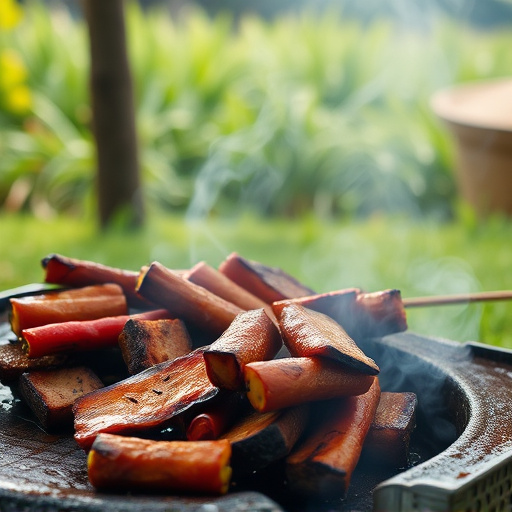
When it comes to crafting the perfect BBQ beef brisket recipe, understanding cooking times and temperatures is key. The process typically involves slow-cooking the meat at a low temperature for an extended period, allowing the collagen in the brisket to break down and transform into delectable, tender flesh. For optimal results, aim for an internal temperature of around 165°F (74°C). This magic number signifies that the brisket is safe to eat and that the tough connective tissues have miraculously morphed into mouthwatering, succulent meat.
Different cuts of brisket may have slightly varying cooking times. Generally, a whole packer brisket will take approximately 1 to 1.5 hours per pound when cooked at 225°F (107°C). However, it’s crucial to monitor the temperature regularly using a meat thermometer. This ensures you achieve the perfect level of doneness without overcooking or undercooking your BBQ beef brisket recipe.
Resting and Slicing: Ensuring Maximum Juicy Results

After slowly cooking your BBQ beef brisket to perfection, resting it properly is crucial for achieving maximum juiciness and flavor development. During rest time, which typically lasts about 30-60 minutes, the meat’s juices redistribute throughout, ensuring each bite is filled with rich, tender goodness. This step is essential in a BBQ brisket recipe as it prevents the meat from drying out or becoming tough, especially for those slices destined for sandwiches.
Slicing against the grain is another key technique to make your BBQ beef brisket sandwich-ready. By cutting across the long muscles of the brisket, you create thinner, more manageable slices that glisten with juices. This simple act can transform a hearty cut of meat into an irresistible sandwich component, allowing guests to savor every juicy bite.
Creative Sandwich Ideas: Pairing Brisket with Toppings

Take your BBQ beef brisket recipe to the next level by getting creative with sandwich toppings. Beyond the classic combination of brisket, barbecue sauce, and coleslaw, there’s a world of flavors to explore. Consider adding crispy fried onions for a sweet and savory kick, or pile on some shredded cheddar cheese for an indulgent touch.
For a burst of freshness, incorporate jalapeño slices or avocado chunks. A sprinkle of smoked paprika or a drizzle of peppery aioli can also add depth of flavor. Don’t be afraid to experiment with unique combinations—maybe even try a sweet and spicy mix with pineapple chutney and chipotle mayonnaise.
Storage and Reheating: Keeping Your BBQ Brisket Delicious
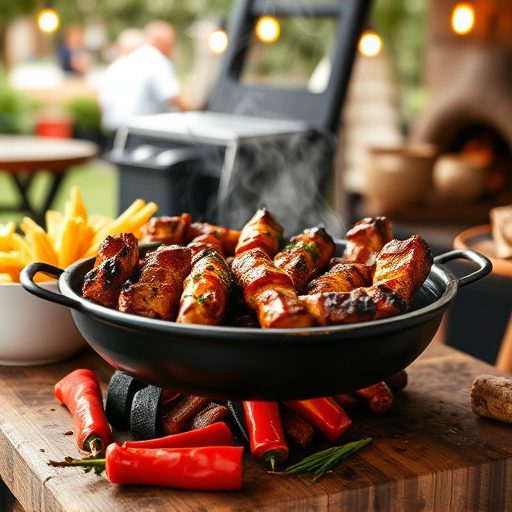
When it comes to storing and reheating your fall-apart BBQ brisket, a few simple steps can ensure it maintains its mouthwatering deliciousness. After cooking your perfect BBQ beef brisket recipe, let it rest for about 20 minutes before slicing it against the grain. This resting period allows the juices to redistribute, keeping the meat tender and juicy. Then, transfer the brisket to an airtight container or wrap it tightly in foil or plastic wrap to preserve its moisture.
For reheating, avoid direct heat as it can dry out the meat. Instead, use a low-temperature setting on your oven or microwave, heating it slowly until it reaches your desired temperature. This gentle approach will keep the brisket tender and flavorful, transforming it into the perfect filling for sandwiches without compromising its quality.
